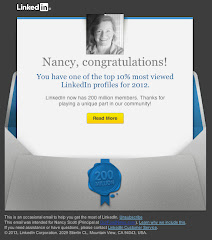Common wisdom has it that Twitter growth is sliding. Maybe. But, in some unexpected ways, I find myself more attached to Twitter than ever.
You see, my use of Twitter has evolved from promotional outreach to community reach. Here's what I mean:
1. I really don't want to build a huge Twitter list. I want a select list and I'm fanatical about dividing my Twitter followers (from all three accounts) into specific categories. Admittedly, sometimes I'm not sure why I do this so religiously. I do have a feeling that some day I'll be glad I did; maybe it's the database marketer in me.
2. Twitter is a community. For instance, I can't watch the nightly news without turning on the Twitter account where my progressive friends hang out. I not only learn a great deal about what's going on, I can exchange thoughts with like-minded friends.
3. Twitter is a secondary key news source. If anything significant (or even of personal interest to me) happens nationwide or globally, I follow the hashtag. That's where I get the most current news and the opinion.
4 Generally speaking, hashtags are a vital search method for me -- less commonly used, perhaps, but equal to Google. Likewise, I don't tweet without hashtags.
5 Twitter is my search engine of choice for matters close to my heart: politics, marketing, writing, etc. Here's where the experts I know and respect hang out.
So, yes. I've noticed some key differences in my Twitter use lately. Anyone else?
-- scrubbed by MarketingBrillo
Thursday, February 13, 2014
Tuesday, February 11, 2014
Short-Form Content Gets the Look
Marketers
today need content and plenty of it. Ebooks and whitepapers make great
giveaways, but, increasingly, users demand their info in bite-size chunks.
Enter short-form content.
By
definition, short-form content is created quickly and consumed even faster.
Widely used examples include tweets, Facebook and/or LinkedIn status updates,
Instagram photos, and even truncated blog posts and articles.
Josh
Schwartz, a data scientist at traffic analysis firm Chartbeat, took
a look at how people scroll through Slate articles.
His data shows that readers can’t stay focused. "When people land on a
story, they very rarely make it all the way down the page. A lot of people
don’t even make it halfway."
Popular apps and software like the following confirm that users are hungry for short and sweet.
- Vine, a mobile app that features seven-second video clips. Example: Airbnb.
- Tapestry, an app that employs digital index cards by which users tell a "short story," one card at a time. Example: Patch.
- Infographics that turn complex textual information into a picture. Example: 10 Ways To Use Infographics.
- Pinterest, a collection of photos gathered from around the web to tell a particular story. Example: Amnesty International.
- Flipboard, software used to "build" your own magazine on any subject, simply by aggregating web content. Example: Evernote.
- Snapguide, an app that lets users create and share concise step-by-step "how-to" guides. Example: School of Architecture, Kingston University London.
- Snapchat, a mobile photo and video sharing service developed by Stanford University students. Talk about short! Messages posted to Snapchat self-destruct after they're viewed. (P.S. Snapchat is H-O-T, having recently turned down a $3 billion buy offer from Facebook.) Also consider SnapChat Stories, eager to grow in ever smaller ways with VC money waiting in the wings. Example: Sorry, no examples are available; they've all self-destructed.
There's
one more short-form app I'm compelled to add because it's so futuristic. This
app -- Summly -- generates short content
for users automatically. Developed by a 17-year-old Brit and recently sold to
Yahoo for a rumored $30 million, Summly delivers machine-generated news
summaries to mobile users.
Subscribe to:
Posts (Atom)



